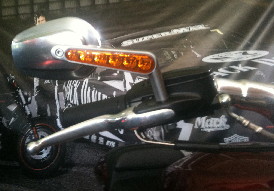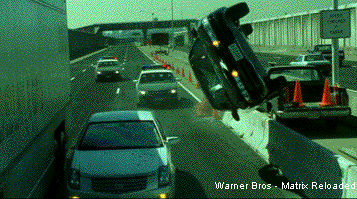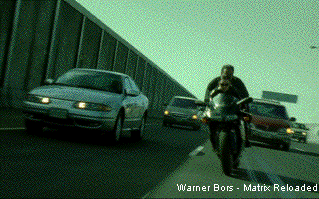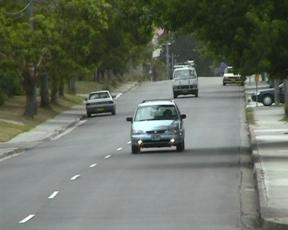In 2002/3 I carried out a review of
daytime running lights (DRL) for the NRMA (a motoring organisation in
New South Wales). At the start of the project I was skeptical
about their effectiveness in Australa. However, I soon located a 1991
CIE report that made a strong case for well-designed DRLs. CIE is the
international authority on lighting standards. I applied the CIE
recommendations to some work I carried out on
flashing
lights on school buses with Dr Alec Fisher and realised that low
beam headlights (maximum luminous intensity 437cd in direction of
oncoming motorists) could only be expected to be marginally effective
during all but very dull days. This helped explain the so-called
"latitude effect" where studies seem to show that DRLs are more
effective in high-latitude locations like Scandinavia. Bright DRLs (up
to 1200cd, as recommended by CIE) would be effective under all daylight
conditions and so were better suited to Australia.
The
latest designs of
dedicated
DRL are very promising - they send light is the optimum direction and
consume very little power (just 12W in the case of a Hella kit). They
dispel most of the criticisms that have been leveled against DRLs.
The
instant you see headlights
at night
you know that a vehicle is
approaching.
DRLs work in the
same way during the day - separating an
approaching vehicle from visual clutter.
This page contains links to DRL studies and some comments on those
studies. A key point is that
most
effectiveness studies are based on a large proportion of vehicles with
low beam headlights but photometric analysis suggests that these are
only marginally effective on all but very dull days. A
2003
GM/SAE paper confirms a large difference in effectiveness for the
various implementations of DRL This is explored further in
my paper for the 2005 Enhanced Safety of Vehicles Conference.
Comments on ATSB report:
My analysis of signal range suggests
that DRL can be designed to be
effective under "bright" daylight conditions. I consider this
worthwhile because many accidents still occur in bright daylight
where the approaching vehicle was not seen (although this has not been
quantified). Days with a light cloud cover in Australia are typical
conditions where constrasts are poor (no shadows) and bright DRLs could
be expected to be quite effective. I did suggest that that a
light sensor could be used to increase DRL intensity in bright
conditions but did not try to analyse the effects:
Page 26 "Control with light sensors - Many Canadian vehicles have
ambient lighting sensors that switch from DRLs to headlights
automatically when light levels fall (ambient light on a horizontal
surface less than 1000 lux according to SAE J2087). This overcomes the
criticism that DRLs could be inadvertently used at night and cause
undue glare. The cost of adding light sensor control is relatively
small,
compared with the cost of a complete DRL installation. It appears feasible to adapt this
technology to increase DRL light intensity (beyond the 1200cd
recommended by CIE) under very bright conditions when glare is not an
issue."
I do not agree that extinguishing DRLs on bright days (to save energy)
is worthwhile.
References and updates
- 6 Jun 23 Journal of Safety Research: Evaluation of the effectiveness of daytime running lights (DRLs) "It
was found that DRL fitment can reduce the overall risk of being
involved in a non-nighttime multi-vehicle crash where vehicle
visibility may be a factor in crash causation by a statistically
significant 8.8%. Estimated crash reductions were higher at dawn or
dusk and in higher speed zones."
- 6 Jun 23 The Guardian: What are daytime running lights on cars and would they make Victorian roads safer?
- 14 May 2019 International Journal of Emergency Medicine 3(1):39-43: Daytime running lights in the USA: What is the impact on vehicle crashes in Minnesota? - RR 1.73 for all crashes and 1.48 for fatal crashes.
- 2 May 14 Philips: DRL Retrofit kit for trucks - Automatic dimming function for night driving + Hella DRL webpage.
- 12 Nov 13 AAP ($): A different perspective on conspicuity related motorcycle crashes
- Previous research often conclude that car drivers fail to yield
to motorcycles (MCs)... In many scenarios car drivers do not fail to
yield to MCs more often than to cars... Only when the car makes a left
turn [across the path of an oncoming vehicle], drivers fail to yield to
MCs relatively often. [comment: this scenario is precisely the one
where long-distance conspicuity is needed, such as bright yellow front turn signals used as DRLs]
- 26 Jan 11. This 2009 NHTSA report The Effectiveness of Daytime Running Lights for Passenger Vehicles
concludes that DRLs have no significant effect on two-vehicle crashes
or vehicle-pedestrian crashes. However the report does caution that
vehicles in the analysis were mostly 1995 to 1999 year models and were
mostly GM vehicles - these are unlikely to represent current DRL
technologies. Also the report acknowledges that some DRL configurations
are far more effective than others but there was no attempt to separate
these in the analysis. Comment: since some types of DRL have marginal
photometric performance the outcome of this study is not unexpected.
Modern brighter DRLs can be expected to be much more effective than the
1990s technologies analysed in this study. In any case, although not
statistically significant, the analysis did find that fatal pedestrian
and cyclist crashes reduced by 19% for cars fitted with DRLs. At the
lower speeds involved in these crashes the less bright DRLs can be
expected to be more effective. IIHS Peer review of NHTSA paper.
- 26 Mar 10. I noticed
this LED turn signal on a Harley Davidson motorcycle. Also it was
pointed out to me that the motorcycle lighting ADR (19) does not appear
to ban turn signals lights from being illuminated continuously (except
when they flash). Therefore it seems that the Harley lights could be
wired to stay on and they would be legal in Australia (and Europe).

- 9 Feb 10 IIHS Q&A on DRLs:
Are DRLs available on vehicles in the United States? First offered
on a handful of 1995 domestic and foreign model passenger cars,
pickups, and SUVs, daytime running lights have become a more common
feature. They are standard on all General Motors, Lexus, Mercedes Benz, Saab, Subaru, Suzuki, Volkswagen, and Volvo models.
Other manufacturers also offer daytime running lights on certain
models. GM offers retrofit kits for vehicles that do not already have
DRLs. The kits can be used on non-GM models, too.
- 11 October 09: Holden HSV E2 has standard daytime running lights.
- 11 Jul 09 VDR: DRL update
- 10 Mar 09 ATZ Online ($): Worldwide First All-LED Headlights for the Audi R8 (with integrated LED Daytime Running Lights).
- 13 Dec 08 Fasteronline: Ring Aurora Daylight Running Lights - LED lamps that comply with ECE R87.
- 1 Oct 08 ACEM (motorcycle industry in Europe): Introduction to the conspicuity research
- note that bright yellow turn signal DRLs have not been evaluated in
this research. In any case there is a need to educate car drivers about
the appropriate response when they see motorcycle DRLs - they need to
know that motorcycle distance and speed is difficult to judge.
- 25 Sep 08 Europe: Daytime Running Lights for all new vehicles from 2011 to increase road safety + Commission
Directive 2008/89/EC of 24 September 2008 amending, for the purposes of
its adaptation to technical progress, Council Directive 76/756/EEC
concerning the installation of lighting and light-signalling devices on
motor vehicles and their trailers.
- 13 Mar 08 Hella FAQ on DRLs (PDF) & DRL website.
- 23 Apr 07 Australian College of Road Safety: Position Paper on DRLs.
- 26 Mar 07 DfT: Daytime running lamps final report (323 kb) - A
review by the Transport Research Laboratory of the DRL reports from the
European Commission. Lacks discussion of the different
effectiveness of various DRLs.
- 20 Dec 06 European Commission: Public consultation on daytime running lights.
- 6 Dec 06 FEMA (PDF): Response to EU consultation paper on DRLs. Comment: several myths are perpetuated in this document. See DAYTIME
RUNNING LIGHTS FOR MOTORCYCLES. In particular:
- DRLs
do not "distract" other motorists - they instantly make the vehicle
more conspicuous. This is an advantage because other road users can
devote more time to detecting less conspicuous objects.
- DRLs do
not create disabling glare. In any case, they have only a fraction of
the luminous intensity of sunlight reflected off glass and polished
surfaces.
- I have suggested that yellow turn-signal DRLs be used on motorcycles so they stand out from white DRLs on cars.
The
best DRL solution is low-powered (LED?) dedicated DRLs with a light
sensor to switch to headlights when ambient light levels drop.
- 14 Nov 06 European Commission: Do other road users suffer from the presence of cars that have their daytime running lights on? (URL no longer working) "no
evidence that the conspicuity of road users in the vicinity of a
DRL-vehicle, as measured by the speed with which their presence was
detected, suffered from a car having its Daytime Running Lights on." + SAVING LIVES WITH DAYTIME RUNNING LIGHTS (DRL) - A Consultation Paper + DRL implementation scenarios.
- 9 Oct 06 AllQuality Custom Auto Accessories: DRL links page + products
- 22 Jun 05 WebElectrics: DRL kit for US$40 (uses
turn signals so not legal in Australia) - thanks Daniel Stern
- 7 May 05 ETSC hardcopy report: The Safety of Vulnerable Road Users
in the Southern,
Eastern and Central European Countries - recommends mandatory DRLs for
all motoriised road vehicles.
- 3 Dec 04 AI: Toyota
recalls 92,577 Celicas to fix daytime lights - too bright.
- COMMISSION INTERNATIONALE
DE L'ECLAIRAGE (CIE - INTERNATIONAL COMMISSION ON
ILLUMINATION) has a new website.
- 10 Nov 04 Institute of Transport Economics, Norway: Daytime running
lights - a systematic review of effects on road safety.
by Elvik R, Christenson PJ, Olsen S. (thanks Robert Anderson)
- 3 Nov 04 Allquality Enterprises (USA): Conversion kit for turn
signal DRLs. Includes a motorcycle
turn signal kit. Note that, from my rough observations, most
motorcyle turn signals are at the lower limit of regulated
brightness. For optimum DRL performance much brighter lights are
required - at the regulated maximum. Also I would like to see a light
sensor to automatically switch to headlights at dusk.
- 25 Oct 04 Lightsout.org: List of studies that
question DRLs (I agree that some types of DRLs should be
discouraged but there is still a strong
case for well-designed dedicated DRLs that operate on a light
sensor to automatically switch to headlights at dusk)
- 23 Oct 04 SAE Paper (cost): 2003-01-2072 : Daytime Running
Lamps (DRLs) for Pedestrian Protection by Paul Thompson.
- 2 Aug 04 SpaceDaily: Enhanced
LEDs Promise To Transform Lighting - Press release from Rensselaer
Polytechnic Institute: Enhanced
LEDs Promise To Transform Lighting
- 27 Jun 04 Auto Channel: Hella
Develops First Headlamp Modules With LEDs.
- 27 Jun 04: Hella
wins design award for new style of dedicated DRL.
- 6 Mar 04 Auto Insider: New
Audi A8 features LED day lights - Light sensors tell the car to
automatically switch from the day lights to the full-blown headlights
when it gets dark. Each day light is composed of five LED lamps.
- 24 Jan 04 ECE: DRAFT
PROPOSAL FOR AMENDMENTS TO REGULATION No. 87
(Daytime running lights) - PDF (thanks Julian Del Beato)
- Stern D., 2002, Where
does glare come from (large PDF), Daniel
Stern Lighting Consultancy, USA.
- Hella, 2002, Daytime driving
lamps: The new light protection factor for greater safety during
the day .
- Functional
Requirements for Daytime Running Lights (Rumar), Report No.
UMTRI-2003-11, May 2003..
- IIHS
Q&A.
- Ryer A., 1998, Light
Measurement Handbook, International Light Inc.
- Koornstra M., Bijleveld F. and Hagenzieker M, 1997, The
Safety Effects of Daytime Running
Lights, SWOV Institute for Road Safety, The Netherlands, R-97-36 (PDF).
- NHTSA, 2000, A
preliminary assessment of the crash-reducing effectiveness of passenger
car
daytime running lamps (DRLs), NHTSA Technical Report DOT HS 808
645, June 2000.
- Bergkvist P., 1998, "Daytime Running Lights - A North American
Success Story", Proceedings
of 17th Conference on the
Enhanced Safety of Vehicles, Windsor, Canada, 1998.
Illustrations of DRLs in "action"


Note that lack of DRLs on the motorcycle. Many cars in the USA
use bright front turn signals as a DRL. I have suggested that
motorcycles
should do the same. This would use no more space than current turn
signals.
The animated GIF (click on image below) illustrates the difference
between ordinary turn
signals and bright DRL turn signals on a motorcycle. The images have
been digitally enhanced.
 400K
Quicktime movie
400K
Quicktime movie
6 Apr 05 New ESV05 paper
DAYTIME
RUNNING LIGHTS FOR MOTORCYCLES





